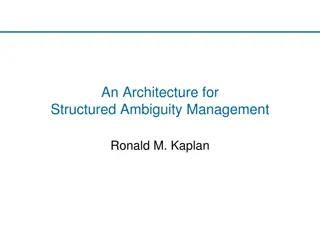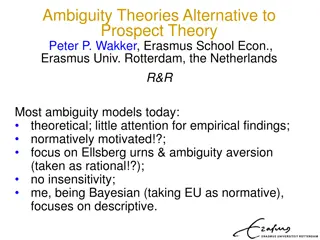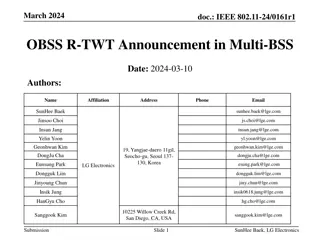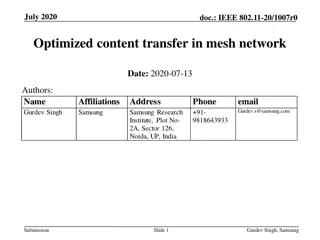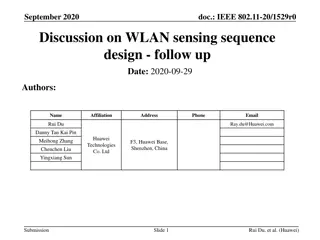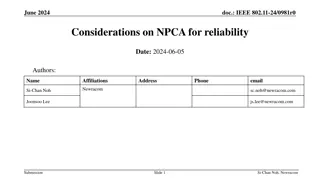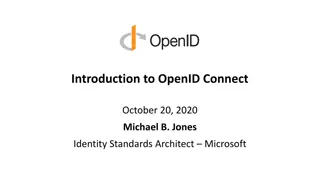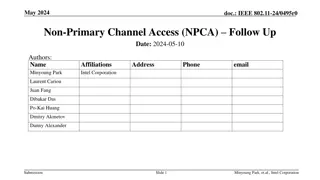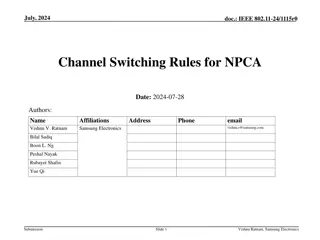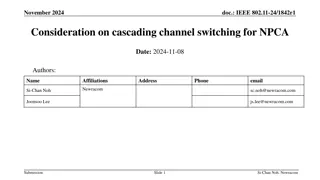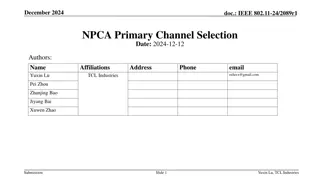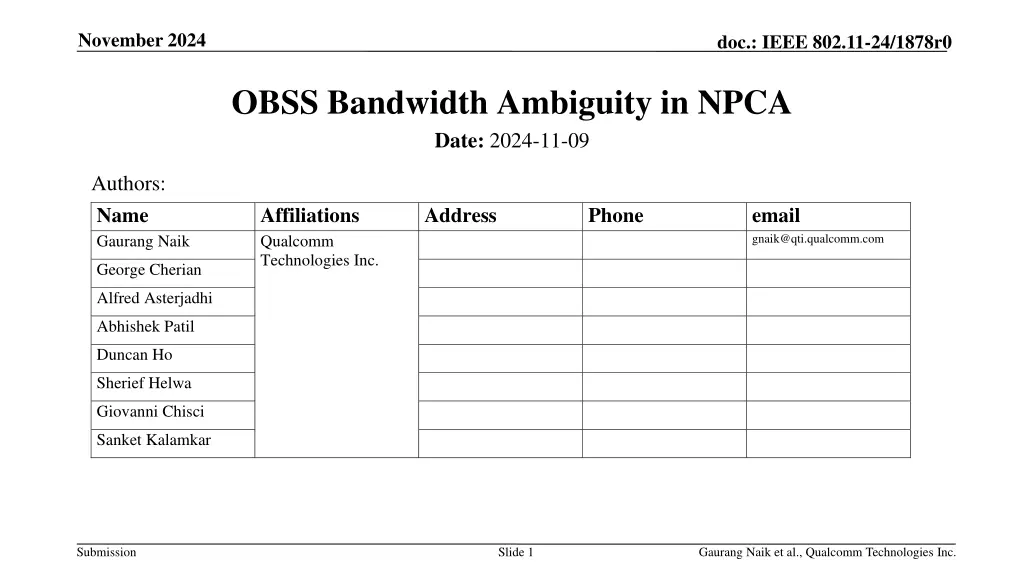
Understanding Bandwidth Ambiguity in NPCA for IEEE 802.11-24
Explore the challenges faced in determining bandwidth in NPCA for IEEE 802.11-24, focusing on OBSS situations, RTS/CTS frames, and 320 MHz signaling ambiguity. Learn about proposed solutions and considerations for effective communication protocols.
Download Presentation

Please find below an Image/Link to download the presentation.
The content on the website is provided AS IS for your information and personal use only. It may not be sold, licensed, or shared on other websites without obtaining consent from the author. If you encounter any issues during the download, it is possible that the publisher has removed the file from their server.
You are allowed to download the files provided on this website for personal or commercial use, subject to the condition that they are used lawfully. All files are the property of their respective owners.
The content on the website is provided AS IS for your information and personal use only. It may not be sold, licensed, or shared on other websites without obtaining consent from the author.
E N D
Presentation Transcript
November 2024 doc.: IEEE 802.11-24/1878r0 OBSS Bandwidth Ambiguity in NPCA Date: 2024-11-09 Authors: Name Gaurang Naik Affiliations Qualcomm Technologies Inc. Address Phone email gnaik@qti.qualcomm.com George Cherian Alfred Asterjadhi Abhishek Patil Duncan Ho Sherief Helwa Giovanni Chisci Sanket Kalamkar Submission Slide 1 Gaurang Naik et al., Qualcomm Technologies Inc.
November 2024 doc.: IEEE 802.11-24/1878r0 Recap Non-Primary Channel Access (NPCA) feature in UHR enables an AP and a non-AP STA to communicate on a nonprimary channel when the primary channel is busy due to OBSS traffic TGbn has agreed to the following: TGbn defines a mode of operation that enables a STA to access the secondary channel while the primary channel is known to be busy due to OBSS traffic or other TBD conditions. The mode of operation shall not assume that the STA is capable to detect or decode a frame and obtain NAV information of the secondary channel concurrently with the primary channel. A BSS shall only have a single NPCA primary channel (name TBD) on which the STA contends while the primary channel of the BSS is known to be busy due to OBSS traffic or other TBD conditions. Submission Slide 2 Gaurang Naik et al., Qualcomm Technologies Inc.
November 2024 doc.: IEEE 802.11-24/1878r0 Determining the bandwidth of RTS/CTS frames When an OBSS transmission preceded with an RTS/CTS frame is received, before switching to NPCA Primary, an NPCA STA must perform the following: Classify the PPDU carrying the RTS/CTS frame as an inter-BSS or intra-BSS PPDU, and Determine bandwidth of OBSS PPDU and whether the OBSS transmission overlaps with the NPCA primary If the OBSS RTS frame does not include a bandwidth signaling TA, NPCA STAs cannot determine the bandwidth of the OBSS TXOP And, therefore, the NPCA STA cannot determine whether the OBSS transmission overlaps with the NPCA primary Thus, we propose that if the received OBSS RTS frame does not include a bandwidth signaling TA, NPCA switch to the NPCA primary channel must not be allowed A CTS frame does not include the Transmitter Address Thus, upon receiving a CTS frame an NPCA STA cannot determine Whether the SERVICE field carries the bandwidth or not In some cases, whether the frame is intra-BSS or inter-BSS Thus, we propose that if a CTS frame is received without receiving the soliciting (MU)RTS frame, NPCA switch to the NPCA primary channel must not be allowed Submission Slide 3 Gaurang Naik et al., Qualcomm Technologies Inc.
November 2024 doc.: IEEE 802.11-24/1878r0 Ambiguity in 320 MHz signaling When an NPCA STA classifies a PPDU as inter-BSS PPDU and acquires the bandwidth information from that PPDU If the PPDU bandwidth is 160 MHz or less, the NPCA STA can unambiguously determine whether the OBSS PPDU overlaps with NPCA Primary or not The same applies if the PPDU bandwidth is 320 MHz and the exact bandwidth configuration (320 MHz-1 or 320 MHz-2) is signaled However, when a 320 MHz PPDU is non-HT duplicate and carries an RTS frame, it does not carry the bandwidth configuration Which causes ambiguity at the NPCA STA as to whether the NPCA Primary channel is occupied For example, for the configuration shown in the adjacent figure, an NPCA STA that receives an RTS frame from an OBSS STA on its BSS Primary and receives the 320 MHz signaling, the NPCA STA cannot distinguish between Case-A and Case-B Thus, the occupancy of NPCA Primary is ambiguous when a 320 MHz OBSS non-HT dup PPDU carries an RTS frame Thus, we propose that if an NPCA STA receives an OBSS RTS frame in a non-HT dup PPDU that indicates a 320 MHz bandwidth, NPCA switch to the NPCA primary channel must not be allowed BW signaling for RTS NPCA APs BSS BW 320MHz-1 BSS Primary NPCA Primary Case-A: OBSS PPDU BW 320MHz-1 Case-B: OBSS PPDU BW 320MHz-2 Submission Slide 4 Gaurang Naik et al., Qualcomm Technologies Inc.
November 2024 doc.: IEEE 802.11-24/1878r0 Summary In this contribution, we highlight the cases where an NPCA STA cannot unambiguously determine whether the OBSS transmission overlaps with the NPCA primary channel These cases are: When an RTS frame carried in a non-HT duplicate PPDU does not include the bandwidth signaling TA, or The RTS frame includes the bandwidth signaling TA and the signaled bandwidth is 320 MHz When a CTS frame carried in a non-HT duplicate PPDU is received without receiving the soliciting RTS/MU-RTS frame We propose that in these cases, a switch to the NPCA primary channel must not be allowed Submission Slide 5 Gaurang Naik et al., Qualcomm Technologies Inc.
November 2024 doc.: IEEE 802.11-24/1878r0 Straw Poll Do you agree that: if an NPCA STA receives an OBSS RTS frame in a non-HT duplicate PPDU that does not include the bandwidth signaling TA, the NPCA STA shall not switch to the NPCA Primary channel? if an NPCA STA receives an OBSS RTS frame in a non-HT duplicate PPDU that includes the bandwidth signaling TA and the signaled PPDU bandwidth is 320 MHz, the NPCA STA shall not switch to the NPCA Primary channel? if an NPCA STA receives a CTS frame in a non-HT duplicate PPDU without receiving the soliciting OBSS RTS or OBSS MU-RTS frame, the NPCA STA shall not switch to the NPCA Primary channel? Submission Slide 6 Gaurang Naik et al., Qualcomm Technologies Inc.




